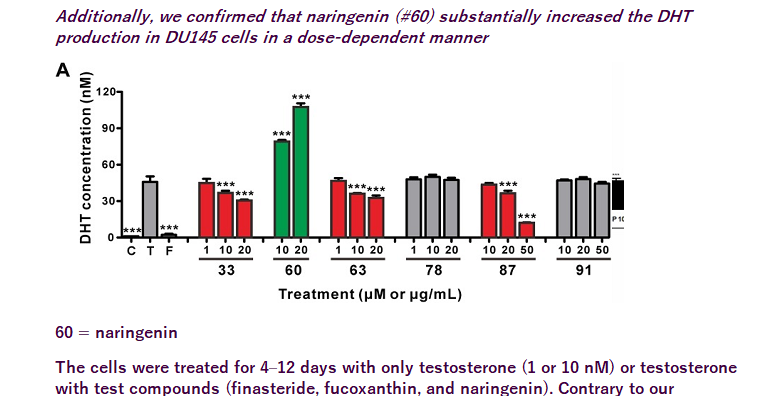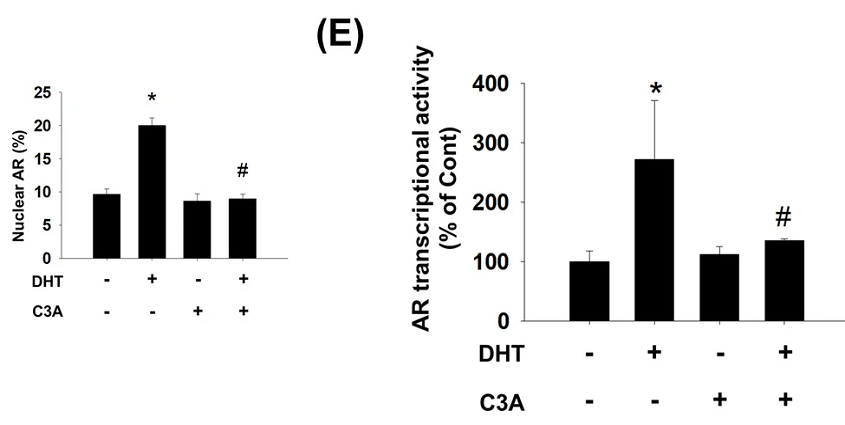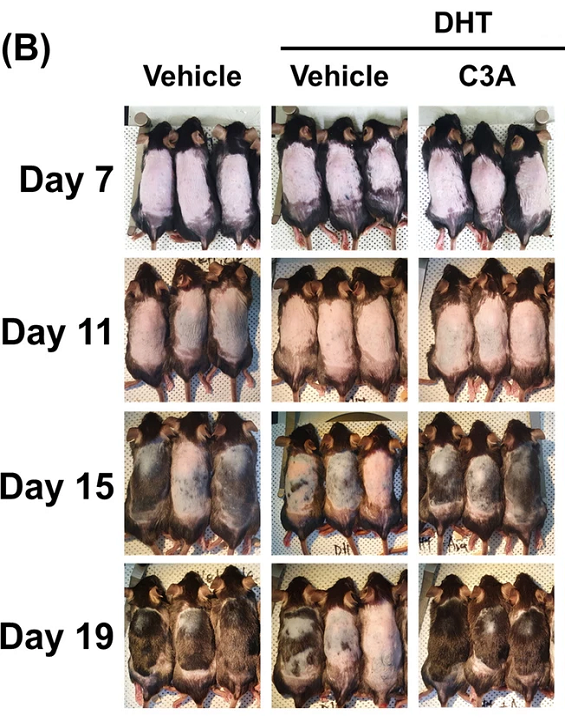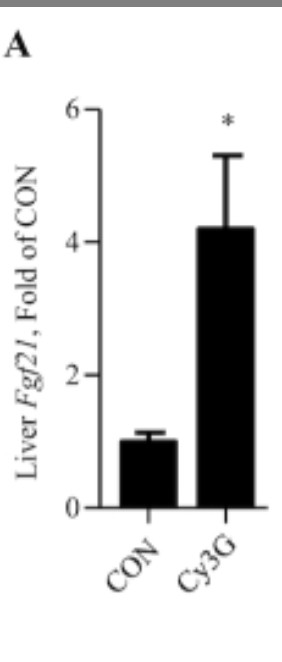Cyanidin-3-O-glucoside (C3G), the next polyphenolic StAR ?
-
Through reading about polyphenols I discovered this interesting compound that possibly has some interesting effects. It seems to boost Progesterone,Pregnenolone and Testosterone and various steroidogenic enzymes, especially the rate limiting enzyme StAR (hence the title). It also increases the number of androgen receptors in one study.
It also increases the anti-aging gene klotho and has an anti-inflammatory effect via COX-2.
-
"...cyanidin-3-O-glucoside (C3G) and its main metabolite protocatechuic acid (PCA) significantly increased testosterone and luteinizing hormone (LH) levels in the serum of rats, and improved sperm quality."
-
"...C3G and PCA significantly up-regulated the gene expressions of Star, Cyp11a1, Cyp17a1, Cyp19a1, Cyp7a1, Hsd3b1, Hsd3b2, Hsd17b3, Scrab1, and Ass1 in testicular. In Leydig cells"
- " Interestingly, C3G improved the expression of LH and FSH receptor in the testis in mice exposed to Cd. Furthermore, C3G activated the signaling pathway related to the synthesis of testosterone processing."
- "The results demonstrated that all four kinds of anthocyanins can inhibit ROS generation, alleviate mitochondrial membrane potential damage, and contribute to increased testosterone. Among them, Cy-3,5-diglu with diglycoside performed best on antioxidative ability and improved cell dysfunction and upregulated the expression of the steroidogenic acute regulatory protein (StAR). "
- Again it increases StAR but also CYP11A1 which converts cholesterol into pregnenolone (https://en.wikipedia.org/wiki/Cholesterol_side-chain_cleavage_enzyme) and 3bHSD which increases Progesterone.
"After being cultured in a medium containing C3G and Pb, R2C cells exhibited an increase in progesterone concentration compared with the Pb treatment, as a result of up-regulation of the expression of the steroidogenic enzymes steroidogenic acute regulatory protein (StAR), 3β-hydroxysteroid dehydrogenase (3β-HSD) and cytochrome P450 enzyme cholesterol side chain cleavage enzyme (CYP11A1).
- Helps against heat stress in testicles
"It was found that C3G and PCA restored the external diameter and thickness, and alleviated atrophy and vacuolation of seminiferous tubules. Simultaneously, C3G and PCA enhanced testicular heat stress tolerance through reducing superfluous eIF2α phosphorylation and stress granule formation."
- It lowers weight gain on a high fat diet and increases klotho more than 3 fold.
"... associated with increased expression of genes that encode FGFR1 and β-klotho (>3-fold, P < 0.05)"
- It did not have a significant effect on hormones in this study, but more importantly it increased the number of androgen receptors, which is even better since you dont have the danger of aromatization that you would get from increased Testosterone.
- It lowers serotonin by about 30% in platelets and protects against thrombosis on HFD.
Now you might wonder where do I get this stuff from? Nature has you covered.
Blackberries are considered a major source of C3G with about a 150mg/100g, BUT out of all foods by far the most C3G has black elderberry with about 800mg/100g! (http://phenol-explorer.eu/contents/polyphenol/9).
So the easiest and cheapest way to get C3G is probably through elderberry juice, which is widely available.
Even better, the most androgenic anthocyanin from study 4 is also contained in elderberry, just less concentrated.
Other foods than those two barely contain C3G, the third best option are black grapes with about 19mg/100g.
So black- and elderberries are the way to go.
Has anybody tried elderberry juice?
-
-
Maple. Maypole
Catch and carry.
Ash and Ember.
Elderberry.In Germany, elderberry juice is mixed with hot water and some extra sugar as a winter beverage. It's called Kindergrog, which is the children's version of real Grog (which is just hot water with rum and sugar). I still have a lot of those during the winter months. I haven't noticed anything special, but I never get colds during winter time, only during fall before it's time to drink it.
-
In the US, American elderberry (Sambucus canadensis) is more prevalent than the European (black) elderberry (Sambucus nigra).
S. canadensis "individuals ranged nearly threefold from 1308 to 4004 µg [of cyanidin 3-glucoside equivalents] (cy3-GE)/g on a fresh weight basis" per this paper that assesses 14 different varieties in the US.
Total phenolic, anthocyanin contents and antioxidant capacity of selected elderberry (Sambucus canadensis L.) accessionsComparing the two species of elderberry in a metanalysis, the following paper concludes this about their composition:
"The most abundant type of anthocyanidin in the European and the American elderberries is cyanidin. In S. nigra, the anthocyanins are not acylated, while in S. canadensis the major individual anthocyanins are acylated with E-p-coumaroyl functionality at C-3. Acylation was reported to stabilize anthocyanins against heat and light. However, glycosidation was observed to improve the stability of anthocyanins against light, but not against heat. Despite the structural variation of the anthocyanins—-represented by a number of hydroxyl groups and the substitution of hydroxyl groups with methoxyl groups, as well as the type and number of sugar residues attached to the flavylium cation via glycosidic linkages—the literature reveals that the anthocyanins of different cultivars of elderberry share several pharmacological effects."
Elderberry Extracts: Characterization of the Polyphenolic Chemical Composition, Quality Consistency, Safety, Adulteration, and Attenuation of Oxidative Stress- and Inflammation-Induced Health Disorders -
@Kvothe Interesting , never heard of those. But Ill get some elderberry juice and try it out.
The dose might be important. I haven't looked into the HED of all those studies and approximately how much elderberry juice that translates to , yet.
-
@Lejeboca Thanks!
-
@Mauritio Whats your view on black bean extract which also contains C3G, might it be a more economical form to take....Dunno
-
@Not_James_Bond
Depends on the cost.Elederberry juice is good. Dried elderberries are pretty economic since they contain a lot more C3G per gram.
-
I posted a lot more studies on C3G in this thread on the forum that had to do with Ray Peat.
just too lazy to post them all here. -
Thanks for putting all of this together, @Mauritio .
I kept an eye on the thread at RPF and was mildly interested, but when I saw that it induces uncoupling AND it increases bile output, I just had to try it.
Like someone mentioned on the other thread, using this with Pu-erh is probably going to be highly effective. The increased use of acetylcoa into cholesterol and increased bile acid synthesis is going to be super effective for reducing reductive stress, not to mention the uncoupling effect and enhanced sirt6 activity.
Then you have the increased star activity too. Thus is just a really cool compound.
So far I’m on day two, and I can say that it does really work for stimulating digestion. I have an issue with sluggish peristalsis that weakly responds to pretty much everything. Huperzine A seems moderately effective, but higher than 200mcg I get cramps. Magnesium sucks, and everything else is kind of useless.
I’ve taken two doses so far, and both times it crashed me pretty hard, mainly because my digestive system started working too abruptly. I’m thunking that if I keep going,
-
Thanks for mentioning. I forgot about taking it. It made me kind of wired but tired after a while ,but I did enjoy it. And might try it again.
-
@Mauritio said in Cyanidin-3-O-glucoside (C3G), the next polyphenolic StAR ?:
Thanks for mentioning. I forgot about taking it. It made me kind of wired but tired after a while ,but I did enjoy it. And might try it again.
Oops. I actually wrote this like a month ago, but when accessing the forum yesterday from my phone this posted for whatever reason and I didn't notice.
I've also stopped using it. It was just way too damn stimulating on the digestive system. I did like the pro-dopamine effects though, very noticeable and powerful, most definitely.
-
@Mauritio said in Cyanidin-3-O-glucoside (C3G), the next polyphenolic StAR ?:
Thanks for mentioning. I forgot about taking it. It made me kind of wired but tired after a while ,but I did enjoy it. And might try it again.
Looked promising, but it blocks DHT / androgen receptor unfortunately , https://www.sciencedirect.com/science/article/abs/pii/S0014299923007513 https://ars.els-cdn.com/content/image/1-s2.0-S0014299923007513-gr5.jpg
,
(a lot of these have anti androgen / dht effects alongside the estrogen lowering , maybe if something is significantly more potent on estrogen effects would outweigh idk, some are neutral but i think the only one ive seen with opposite effect on dht is naringenin (not naringin)

,maybe the increased star is trying to balance the lowered AR activation (and increase androgen receptors as theyre being activated less? id like to see if they measured activation in that rat study cant find it , they used low dose not sure what dose was, maybe theres an optimal dose to not get the anti androgen effect but idk if the star effect would happen then)
"DHT increased AR mRNA and AR protein expression, but their expressions were reduced to control levels with C3A treatment "
(works same for c3a or c3g)

https://onlinelibrary.wiley.com/doi/full/10.1002/fft2.139 in vitro C3G here inhibits mitochondrial respiration/oxygen consumption at 150nM , in humans in blood hits ~150nm from 500mg so looks too high a dose
https://bpspubs.onlinelibrary.wiley.com/doi/10.1111/bph.12676

But C3A / C3G does look effective for hair regrowth w short term use,
(interesting mention of lower mitochondria calcium mechanism for hair loss reversal also
https://www.researchgate.net/publication/359068150_Cyanidin_3-O-arabinoside_suppresses_DHT-induced_dermal_papilla_cell_senescence_by_modulating_p38-dependent_ER-mitochondria_contacts
worked for hair regrowth topically with oil:ethanol 7:3 ratio at 500uM every 2 days, maybe 100mg a day topically , & https://ars.els-cdn.com/content/image/1-s2.0-S0014299923007513-gr2.jpg
-
C3G increases FGF21 4-fold in the liver.
That's probably one of the MoAs of how it increases metabolism.
-
Elderberry and quinine synergistic against influenza virus.
https://pubmed.ncbi.nlm.nih.gov/40218964/"Notably, six of the 32 compounds demonstrated significant antiviral activity in an in vitro TZM-bl assay against two strains of HIV-1 virus, CXCR4-dependent NL4-3 virus and CCR5-dependent BaL virus. "
https://pubmed.ncbi.nlm.nih.gov/39314315/ -
Elderberry extract increases testosterone and steroidogenic enzymes strongly. It lowers aromatase and 5areductase, which is unfortunate. To me it doesn't feel like it lowers DHT at all. Quite the opposite. So I'm wondering if the increase in androgen receptors and steroidogenic enzymes is enough to compensate .
And, 5aR isn't the only pathway towards DHT, and the backdoor pathway wasn't tested so maybe it has to do with that .